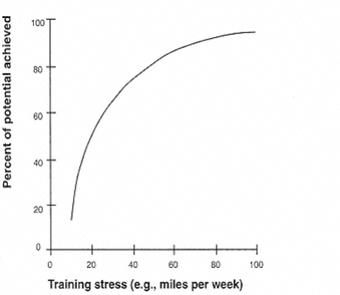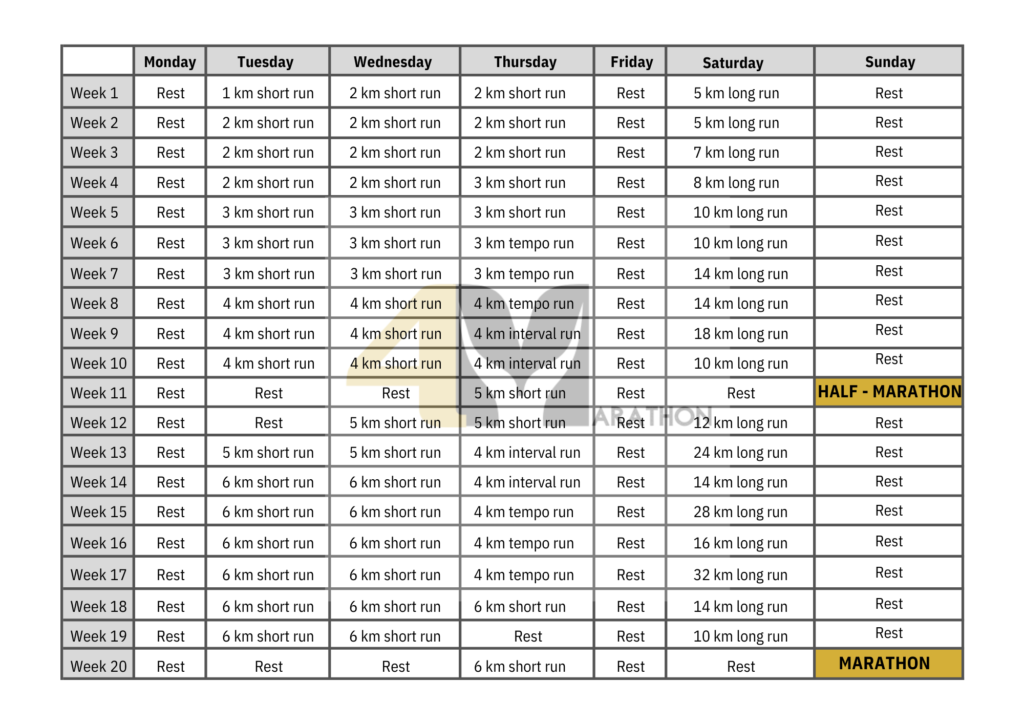Marathon Training Plan: How To Run a Marathon in 20 Weeks
Firstly, let us congratulate you on your decision to run a marathon. You now belong to a very small portion of people who are crazy enough and decide to take a plunge :). In order to do this, you will definitely need a quality marathon training plan.
A marathon training plan is a detailed schedule of the daily activities that you have to undergo in order to prepare your body and mind for a load that 26 miles and 385 yards (42.2 km) will definitely be.
Our marathon training plan was designed for beginner and intermediate runners and it lasts 20 weeks. 20 weeks is a time during which even a novice runner can prepare well for a marathon, provided he strictly follows the schedule of runs and exercises.
Based on olympic coach knowledge
Our plan has already successfully helped many people run their first marathon. It was compiled by us, the runners from AllForMarathon, both on the basis of our own marathon experience but also on the basis of the worldwide known running principles summarized in the book Daniels’ Running Formula.

Jack Daniels is a world-famous Olympic athlete coach and running coach who put together a set of running principles that athletes have been following for years. They are all summarized in his book which is a bestseller and also the running Bible for many professional runners.
Jack Daniels’ running principles
Let’s have a look at some of the running principles that will be helpful for you in the following 20 weeks.
The body reacts to stress
Acute reaction to running stress– what happens when a non-trained individual starts to run – heart rate speeds up, stroke volume increases, ventilation and depth of breathing go up, muscles feel the fatigue
Training reaction/effect to running stress– comes from repetitive chronic exercise, muscles become stronger and blood flow more generous, lower heart rate due to stronger heart, lower blood pressure, lighter steps, lower weight
Rate of achievement
Your running muscles need time to adjust to new levels of stress caused by running. That is why it is extremely important to slowly increase the weekly. Our marathon training plan does exactly that. By steadily increasing weekly mileage, the chance of early running injury decreases. That is what makes our training plan ideal for someone who is just starting with running.
Law of diminishing returns
The more intensity you add to the training, the lower are additional improvements to fitness. When you start to regularly run, you will improve very quickly. But the more and more you run, the harder it will be to reach further improvement.

Once you start to train, you will notice that you will be quite quickly (within 1 – 2 months) able to run a half marathon. But don’t get mistaken. The full marathon is a different discipline and you will need to work much harder to get there.
Accelerating setbacks
Low levels of training produce few setbacks (such as injury, illness, or lack of interest in training), and harder and harder training increases exponentially the potential for setbacks. That is especially true in the case of marathon training.
More of the principles in much more detail can be found in Daniels’ Running Formula. I definitely advise you to read it, it will help you to become a much better runner.
Marathon training plan
Now let’s have a look at our marathon training program.

Marathon training plan MILES version

Marathon training plan KILOMETRES version
Types of marathon training runs
Marathon training consists of several types of runs and exercises, which must be repeated every week for 20 weeks. Each of these types of runs fulfills its specific function.
One of the basic rules of marathon training is that we should always keep in mind what we are trying to achieve with a given training unit. Just as we aim to run a marathon and we make it our goal, every training run must have its own purpose to get us there.
Easy (recovery) run
Slow, daily, usually morning run that lasts between 30 – 60 minutes. It is extremely important to growing the oxygen processing capacity of your running muscles. Steady aerobic running helps you to grow new mitochondria (membrane parts of your muscle cells) which play a key part in energy production in muscles.
A4M marathon training program consists of 2 – 3 easy runs per week, specifically on Tuesday, Wednesday and Thursday. If you skip it occasionally, it is not a tragedy, but make sure not to skip any of the long runs.
Long run
Steady run at an easy pace, maximum 20 miles (32 km). It is the best training unit for muscle cells adaptation to running. The long-run leads to fluid loss and glycogen depletion. Also, it makes you burn fat as it relies on fat as fuel.
Most marathon training programs schedule long runs for weekends and we are no exception. On the weekend, most people have more free time, which is necessary, as these training units require hours. Our marathon training plan schedules long runs for Saturday rather than Sunday in order to give you a day off for recovery before the new working week begins.

Starting with a 3-mile (5 km) long run on Week 1 and gradually increasing the distance until Week 17 with the longest 20-mile (32 km) run of your training.
As you may notice, later parts of your marathon training include the so-called “stepback” week decreasing your long-run mileage. This is critical to keep you motivated, give you more strength and lower the risk of injury that is steadily growing at this stage during your workouts.
A long training run is also a great time to experiment and test your running equipment (such as running shoes or underwear) and also hydration and nutrition strategy. You definitely want to figure out these prior to your first marathon.
Threshold (tempo) run
Also called tempo run, we rank this kind of run between so-called quality training runs. It is a comfortably hard run that usually takes about 20 minutes. In the race, you should be able to keep it for about an hour.
The goal of this training unit is to maintain steady intensity effort for a prolonged period of time. The tempo run is also increasing your lactate threshold which may show up crucial on a race day.

Interval run
Another quality training type of run. It consists of 20 – 50 series of quick runs (intervals) each between 30 seconds and 2 minutes long alternated by walking breaks of a similar length.
An interval run is a speed run at approximately 90% of your sprint pace. Its purpose is to stress your oxygen consumption limits (you will struggle to take a breath) which will increase the efficiency of your oxygen consumption in long term.
Intervals are the hardest type of training that our marathon training plan includes. Even though it is demanding, you need to understand that such speed training has its importance when you train for a marathon. It improves the mechanics of your running and makes you a better and more efficient runner.
Rest
Rest days are a crucial part of all marathon training plans and we schedule them for Mondays, Fridays and Sundays. This is mostly to give you solid recovery time after your Saturday long runs that might get extremely demanding later on.
Scientists agree that it is actually during the rest time when you properly refuel your glycogen-depleted muscles and your muscles are actually growing stronger. You will not be able to run hard unless you are properly rested.
Make sure to eat plenty of carbs (pasta, pizza, potatoes) to refill depleted muscle glycogen and a lot of protein (red meat, eggs, dairy) as well. Protein will boost the growth and repair of muscle tissues which is exactly what you aim for in a marathon training program.
If your food is not so rich in protein or you simply want to boost your protein intake, I recommend trying a protein shake that will do a great job as well.
But it is not only about eating. A day without running will also help to keep your morale high. You know you can afford it and take a day off since you are consistent with the scheduled runs.
Strength training
Even though we don’t officially schedule the strength training into our marathon training plan, it is highly advised to strengthen your leg muscles, abdominals, and shoulders weekly.
Why is it important? In short, stronger leg muscles mean more power for your legs and less chance of injury. Stronger abdominals and shoulders lead to better posture and better weight distribution.
You will notice, especially during long runs, that you will experience pain in the abdominal area. It is because abdominals are used much more during running than you would guess. They help to carry your bodyweight so the stronger they are the less weight is left to be carried by your legs.

Shoulders are not an exception. Underdeveloped shoulder muscles (mainly deltoid and trapezius) will worsen your posture while running, possibly leading to exertional headaches.
We advise you to do strength exercises on your rest days (ideally Monday and Friday), 30 minutes per day. This will dramatically increase your chances you will reach the finish line on your race day.
For more details, check Top 7 Strength exercises for runners.
Marathon race
Here we go!
As we get closer to the race day and closer to the end of marathon training, we try to slow down a bit.
During weeks 18 – 19 (after finishing 20 miles run on week 17), you may notice a major drop in mileage. This is to allow your body to regenerate fully and replenish your muscles with the necessary fuel.
Last week it is a time to taper and prepare mentally. One short run 2-3 days prior to the race will keep you in shape.
Racing is the ultimate expression of a runner’s ability, training and motivation. Every race should be thought out, prepared for and performed with determined ferocity. If you followed the training plan properly, you should not worry at this point, you have all the necessary fitness to complete it.
Let me give you a few additional tips though:
- It is no time to experiment now – no new running shoes to look better on the pictures, no new running gels – follow what has been working for you the best during your training
- Choose a bit slower pace for the first half of the race, then increase the pace if you feel good – a marathon is a long event and you don’t want to give all you have early on
- Get ready mentally – remind yourself of your personal reasons why you run in the first place, what keeps you getting up every morning, stick to what you have been through in the last 20 weeks.






